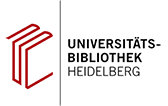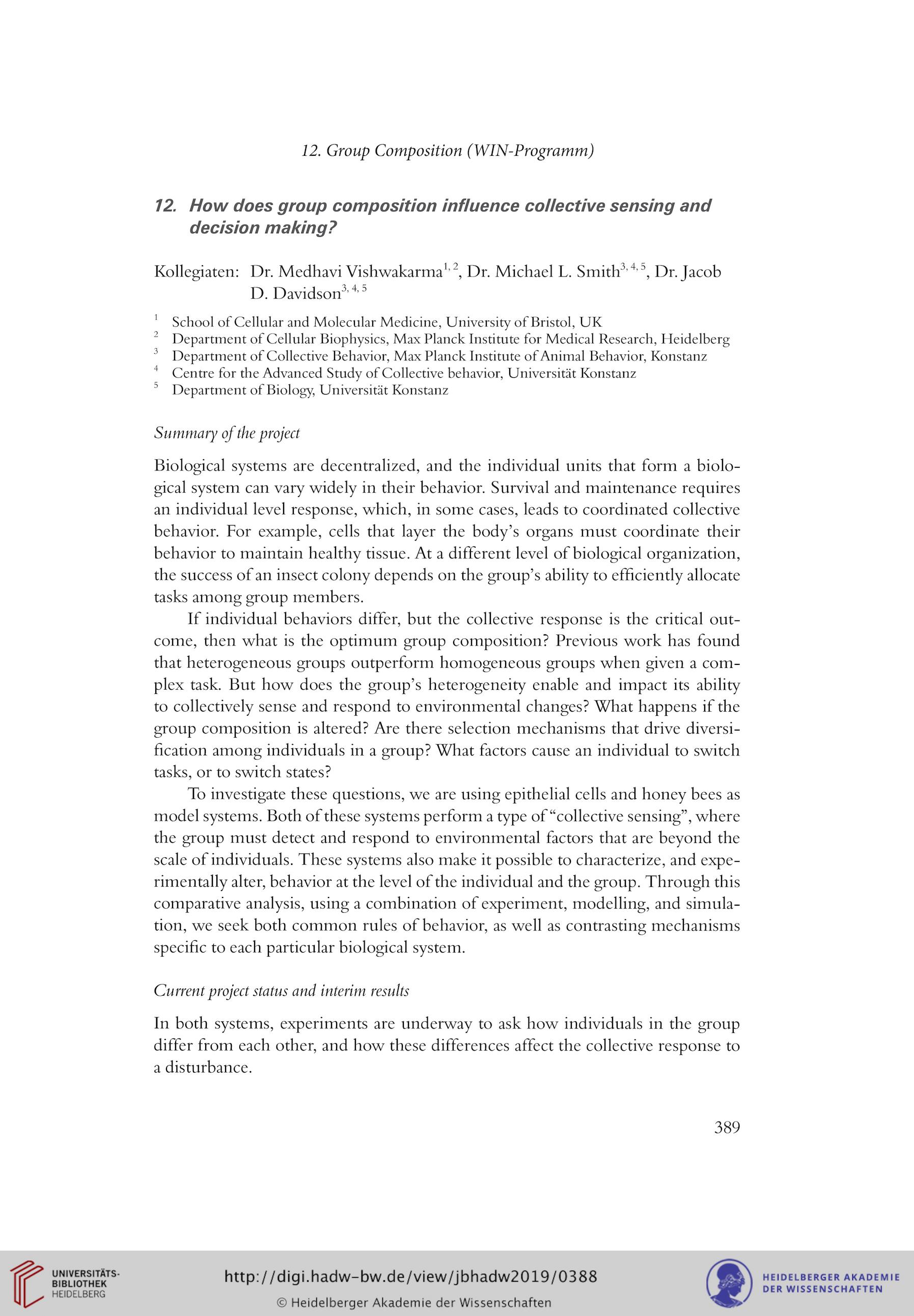Heidelberger Akademie der Wissenschaften [Hrsg.]
Jahrbuch ... / Heidelberger Akademie der Wissenschaften: Jahrbuch 2019
— 2020
Zitieren dieser Seite
Bitte zitieren Sie diese Seite, indem Sie folgende Adresse (URL)/folgende DOI benutzen:
https://doi.org/10.11588/diglit.55176#0388
DOI Kapitel:
D. Förderung des wissenschaftlichen Nachwuchses
DOI Kapitel:II. Das WIN-Kolleg
DOI Kapitel:Siebter Forschungsschwerpunkt „Wie entscheiden Kollektive?“
DOI Kapitel:12. How does group composition influence collective sensing and decision making?
DOI Seite / Zitierlink:https://doi.org/10.11588/diglit.55176#0388
- Schmutztitel
- Titelblatt
- Inhaltsverzeichnis
-
A. Das akademische Jahr 2019
-
11-48
I. Jahresfeier am 18. Mai 2019
- 11-12 Begrüßung durch den Präsidenten Thomas Holstein
- 13-15 Grußwort des Präsidenten der Deutschen Akademie der Naturforscher Leopoldina Jörg Hacker
- 16-21 Rechenschaftsbericht des Präsidenten
- 22-23 Kurzbericht der Sprecherin des WIN-Kollegs Daniela Mier: „JungeWissenschaft in der Akademie: das WIN-Kolleg“
- 24 Verleihung der Preise
-
49-80
II. Wissenschaftliche Vorträge
- III. Veranstaltungen
-
11-48
I. Jahresfeier am 18. Mai 2019
- B. Die Mitglieder
-
C. Die Forschungsvorhaben
- 223-224 I. Forschungsvorhaben und Arbeitsstellenleiter
-
225-331
II. Tätigkeitsberichte
- 225-228 1. Deutsche Inschriften des Mittelalters
- 229-234 2. Wörterbuch der altgaskognischen Urkundensprache (DAG)
- 234-240 3. Deutsches Rechtswörterbuch
- 240-242 4. Goethe-Wörterbuch (Tübingen)
- 242-246 5. Melanchthon-Briefwechsel
- 246-249 6. Altfranzösisches etymologisches Wörterbuch (DEAF)
- 250-255 7. Epigraphische Datenbank römischer Inschriften
- 255-260 8. Edition literarischer Keilschrifttexte aus Assur
- 261-267 9. Buddhistische Steininschriften in Nordchina
- 267-274 10. Geschichte der südwestdeutschen Hofmusik im 18.Jahrhundert (Schwetzingen)
- 275-287 11. The Role of Culture in Early Expansions of Humans (Frankfurt/Tübingen)
- 287-293 12. Nietzsche-Kommentar (Freiburg)
- 293-298 13. Klöster im Hochmittelalter: Innovationslabore europäischer Lebensentwürfe und Ordnungsmodelle (Heidelberg/Dresden)
- 299-305 14. Der Tempel als Kanon der religiösen Literatur Ägyptens (Tübingen)
- 306-310 15. Kommentierung der Fragmente der griechischen Komödie (Freiburg)
- 310-314 16. Kommentierung und Gesamtedition der Werke von Karl Jaspers sowie Edition der Briefe und des Nachlasses in Auswahl
- 314-318 17. Historisch-philologischer Kommentar zur Chronik des Johannes Malalas
- 319-325 18. Religions- und rechtsgeschichtliche Quellen des vormodernen Nepal
- 325-331 19. Theologenbriefwechsel im Südwesten des Reichs in der Frühen Neuzeit (1550–1620)
-
332-341
III. Drittmittel-geförderte Projekte
- 332-335 20. Nepal Heritage Documentation Project
- 335-338 21. Ludwik Fleck und seine ‚Denkkollektive‘: Der (Lemberger) Entstehungskontext seiner Ideen vom Denkstil und Denkkollektiv und ihre interdisziplinäre Rezeption
- 338-340 22. Individualisierung und Demokratisierung der Versorgung von Krebspatienten mittels künstlicher Intelligenz: transdisziplinäre Lösungen und normative Überlegungen
- 340-341 23. EUCANCan: a federated network of aligned and interoperable infrastructures for the homogeneous analysis, management and sharing of genomic oncology data for Personalized Medicine
-
D. Förderung des wissenschaftlichen Nachwuchses
-
I. Die Preisträger
- 343-344 Akademiepreis
- 345 Karl-Freudenberg-Preis
- 346 Walter-Witzenmann-Preis
- 347-348 Ökologiepreis der Viktor-und-Sigrid-Dulger-Stiftung
-
349-351
Manfred-Fuchs-Preis
- 349-350 Julia Burkhardt: „Von Bienen lernen. Das Bonum universale de apibus des Thomas von Cantimpré als Gemeinschaftsentwurf (Analyse, Edition, Übersetzung, Kommentar)“
- 350-351 Thomas Böttcher: „Virulenz krankheitserregender Bakterien, die Entwicklung neuer Antibiotika sowie die Untersuchung der chemischen Interaktionen zwischen Mikroorganismen“
-
II. Das WIN-Kolleg
- 352 Aufgaben und Ziele
- 353-354 Verzeichnis der WIN-Kollegiaten
-
355-385
Sechster Forschungsschwerpunkt „Messen und Verstehen der Welt durch die Wissenschaft“
- 355-357 1. Analyzing, Measuring and Forecasting Financial Risks by means of High-Frequency Data
- 358-363 2. Das menschliche Spiegelneuronensystem: Wie erfassen wir, was wir nicht messen können?
- 363-364 3. Quantifizierung in Politik und Recht am Beispiel von Wirtschaftssanktionen
- 365-368 4. Europäischer Datenschutz und Datenaustausch: interdisziplinäre Bedingungen und internationale Implikationen
- 369-372 5. CAL²Lab – Eine rechtslinguistische Experimentierplattform
- 373-375 6. „Working Numbers“: Science and Contemporary Politics
- 376-379 7. Thermischer Komfort und Schmerz – Untersuchungen zur Dynamik der Schmerz- und Komfortwahrnehmung
- 380-382 8. Charakterisierung von durchströmten Gefäßen und der Hämodynamik mittels modell- und simulationsbasierter Fluss-MRI (CFD-MRI)
- 383-384 9. Zählen und Erzählen. Spielräume und Korrelationen quantitativer und qualitativer Welterschließung
- 385 10. Metaphern und Modelle – Zur Übersetzung von Wissen in Verstehen
-
386-402
Siebter Forschungsschwerpunkt „Wie entscheiden Kollektive?“
- 386-388 11. Heiligenleben: Erzählte Heiligkeit zwischen Individualentscheidung und kollektiver Anerkennung
- 389-392 12. How does group composition influence collective sensing and decision making?
- 393-396 13. Fake News and Collective Decision Making. Rapid Automated Assessment of Media Bias
- 397-399 14. Heterogeneity and Convergence in Shared Data Sources – The Importance of Cognitive Coherence in Collective Decision Making
- 400-402 15. Ein transdisziplinäres Modell zur Struktur- und Musterbildung kollektiven Entscheidens: Synergieeffekte zwischen linguistischen, biologischen und physikalischen Ansätzen
- 403-406 III. Das Akademie-Kolleg
-
IV. Akademiekonferenzen
-
I. Die Preisträger
- 415-440 E. Anhang
- 447-455 Personenregister
12. Group Composition (WIN-Programm)
12. How does group composition influence collective sensing and
decision making?
Kollegiaten: Dr. Mcdhavi Vishwakarma1’2, Dr. Michael L. Smith3’4’5, Dr. Jacob
D. Davidson3,4,5
1 School of Cellular and Molecular Medicine, University of Bristol, UK
2 Department of Cellular Biophysics, Max Planck Institute for Medical Research, Heidelberg
3 Department of Collective Behavior, Max Planck Institute of Animal Behavior, Konstanz
4 Centre for the Advanced Study of Collective behavior, Universität Konstanz
Department of Biology, Universität Konstanz
Summary of the project
Biological Systems are decentralized, and the individual units that form a biolo-
gical System can vary widely in their behavior. Survival and maintenance requires
an individual level response, which, in some cases, leads to coordinated collective
behavior. For example, cells that layer the body’s organs must coordinate their
behavior to maintain healthy tissue. At a different level of biological Organization,
the success of an insect colony depends on the group’s ability to efficiently allocate
tasks among group members.
If individual behaviors differ, but the collective response is the critical out-
come, then what is the Optimum group composition? Previous work has found
that heterogeneous groups outperform homogeneous groups when given a com-
plex task. But how does the group’s heterogeneity enable and impact its ability
to collectively sense and respond to environmental changes? What happens if the
group composition is altered? Are there selection mechanisms that drive diversi-
fication among individuals in a group? What factors cause an individual to switch
tasks, or to switch States?
To investigate these qucstions, we are using epithelial cells and honey bees as
model Systems. Both of these Systems perform a type of “collective sensing”, where
the group must detect and respond to environmental factors that are beyond the
scale of individuals. These Systems also make it possible to characterize, and expe-
rimentally alter, behavior at the level of the individual and the group. Through this
comparative analysis, using a combination of experiment, modelling, and Simula-
tion, we seek both common rules of behavior, as well as contrasting mechanisms
specific to each particular biological System.
Current project Status and interim results
In both Systems, experiments are underway to ask how individuals in the group
differ from each other, and how these differences affect the collective response to
a disturbance.
389
12. How does group composition influence collective sensing and
decision making?
Kollegiaten: Dr. Mcdhavi Vishwakarma1’2, Dr. Michael L. Smith3’4’5, Dr. Jacob
D. Davidson3,4,5
1 School of Cellular and Molecular Medicine, University of Bristol, UK
2 Department of Cellular Biophysics, Max Planck Institute for Medical Research, Heidelberg
3 Department of Collective Behavior, Max Planck Institute of Animal Behavior, Konstanz
4 Centre for the Advanced Study of Collective behavior, Universität Konstanz
Department of Biology, Universität Konstanz
Summary of the project
Biological Systems are decentralized, and the individual units that form a biolo-
gical System can vary widely in their behavior. Survival and maintenance requires
an individual level response, which, in some cases, leads to coordinated collective
behavior. For example, cells that layer the body’s organs must coordinate their
behavior to maintain healthy tissue. At a different level of biological Organization,
the success of an insect colony depends on the group’s ability to efficiently allocate
tasks among group members.
If individual behaviors differ, but the collective response is the critical out-
come, then what is the Optimum group composition? Previous work has found
that heterogeneous groups outperform homogeneous groups when given a com-
plex task. But how does the group’s heterogeneity enable and impact its ability
to collectively sense and respond to environmental changes? What happens if the
group composition is altered? Are there selection mechanisms that drive diversi-
fication among individuals in a group? What factors cause an individual to switch
tasks, or to switch States?
To investigate these qucstions, we are using epithelial cells and honey bees as
model Systems. Both of these Systems perform a type of “collective sensing”, where
the group must detect and respond to environmental factors that are beyond the
scale of individuals. These Systems also make it possible to characterize, and expe-
rimentally alter, behavior at the level of the individual and the group. Through this
comparative analysis, using a combination of experiment, modelling, and Simula-
tion, we seek both common rules of behavior, as well as contrasting mechanisms
specific to each particular biological System.
Current project Status and interim results
In both Systems, experiments are underway to ask how individuals in the group
differ from each other, and how these differences affect the collective response to
a disturbance.
389




